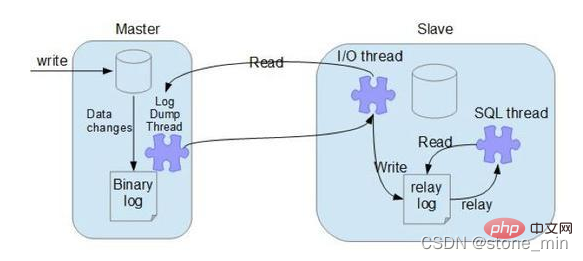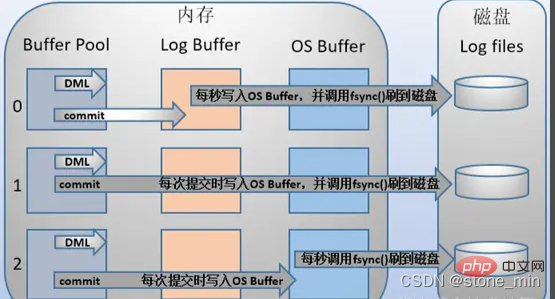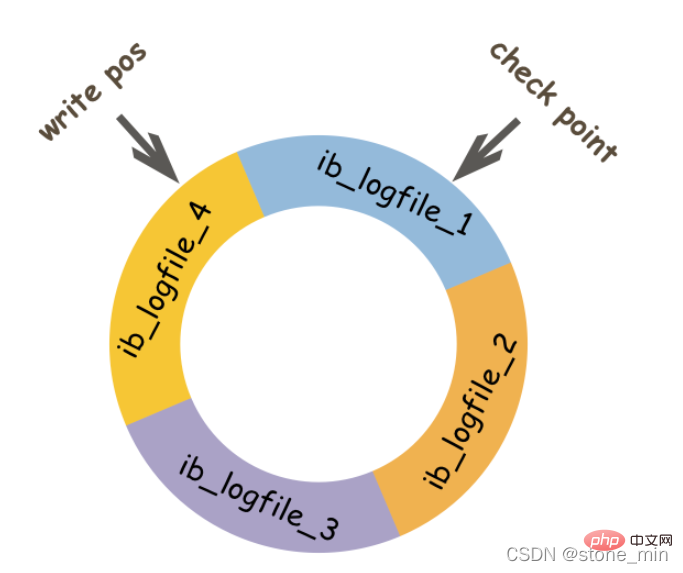
This article brings you relevant knowledge about mysql logs. What we need to focus on is the binary log (binlog) and transaction log (including redo log and undo log). I hope it will be helpful to everyone.

binlog is used to record write operations (excluding queries) information performed by the database and is saved in binary form in the disk. Binlog is the logical log of mysql and is recorded by the server layer. Mysql databases using any storage engine will record binlog logs.
Binlog is written by appending. You can set the size of each binlog file through the max_binlog_size parameter. When the file size reaches the given value, it will be generated New file to save logs.
binlog usage scenarios
Project In actual applications, there are two main usage scenarios for binlog, namely master-slave replication and data recovery.
MySQL master-slave synchronization principle

binlog content
As mentioned above, binlog is a A logical log can be simply understood as a SQL statement, but in fact it also contains the reverse logic of the executed SQL statement. delete corresponds to delete itself and the reverse insert information; update contains information about the data rows before and after the corresponding update is executed; insert contains its own insert and corresponding delete information.
binlog format
There are three binlog formats, namely statement, row and mixed. Before MySQL 5.7.7, statement was used by default, and after MySQL 5.7.7, row was used by default. The format of the log can be modified through binlog-format in the my.ini configuration file.
(1) Statement: Statement-based replication (SBR) based on SQL statements. Each SQL statement that modifies data will be recorded in the binlog.
(2) row: row-based replication (RBR), which does not record SQL statement context-related information, but records which Details of the record being modified.
(3)mixed: According to the above, statement and row Each has its own advantages and disadvantages, so the mixed version emerged to mix the two. Under normal circumstances, the statement format is used for saving. When the statement cannot be solved, switch to row format for saving.
In particular, as mentioned above, the new version (after MySQL 5.7.7) uses the row format by default. The row here has also been optimized accordingly. When encountering the alter table operation, the statement format is used for recording. The rest Operations still use row format.
binlog flushing timing
For the InnoDB storage engine, the binlog will only be recorded when the transaction is submitted. At this time, the record is still in the memory, and MySQL passes sync_binlog controls the flushing timing of binlog. The value range is 0-N:
As can be seen from the above, the safest setting for sync_binlog is 1, which is also the version after MySQL 5.7.7 the default value. However, setting a larger value can improve database performance. Therefore, in actual situations, you can also increase the value appropriately and sacrifice a certain degree of consistency to obtain better performance.
Physical file size of binlog
In the my.ini configuration file, the size of the binlog can be configured through max_binlog_size. When the log volume exceeds the size of the binlog file, the system will regenerate a new file to continue saving the file. What should I do when a transaction is relatively large, or when there are more and more logs, and the physical space it occupies is too large? MySQL provides an automatic deletion mechanism, which can be solved by configuring the expire_logs_days parameter in the my.ini configuration file. The unit is days. When this parameter is 0, it means it will never be deleted; when it is N, it means it will be automatically deleted after the Nth day.
redolog is the proprietary log system of the InnoDB engine. It is mainly used to achieve transaction durability and crash-safe functions. Redolog is a physical log, which records the specific modifications on the data page after the SQL statement is executed.
We all know that when MySQL is running, data will be loaded from disk into memory. When a SQL statement is executed to modify the data, the modified content is actually only temporarily saved in the memory. If the power is cut off or other circumstances occur at this time, these modifications will be lost. Therefore, after modifying the data, MySQL will look for opportunities to flush these memory records back to the disk. But there is a performance problem, mainly in two aspects:
InnoDB interacts with the disk in data units of pages, and a transaction may only modify a few bytes on a page. , if a complete data page is flushed back to the disk, it will waste resources;
A transaction may involve multiple data pages. These data pages are only logically continuous but not physically continuous. Use random IO The performance is too poor;
Therefore, MySQL designed redolog to record the specific modifications made to the data page by the transaction, and then flush the redolog back to the disk. You may have doubts. Originally, I wanted to reduce io. Wouldn’t this add another io? The designers of InnoDB have taken these into consideration at the beginning of the design. Redolog files are generally relatively small, and the process of flashing back to disk is sequential IO, which has better performance than random IO.
Basic concept of redo log
Redolog consists of two parts, one is the log cache redo log buffer in the memory, and the other is the log file redo log file in the disk. Every time the data record is modified, these modifications will be written to the redo log buffer first, and then wait for the appropriate opportunity to flush the modifications in the memory back to the redo log file. This technology of writing logs first and then writing to disk is WAL (Write-Ahead Logging) technology. It should be noted that the redolog is flushed back to disk before the data page. Modifications to the clustered index, secondary index, and undo page all need to be recorded in the redolog.
In computer operating systems, buffer data in user space generally cannot be written directly to the disk, and must pass through the operating system kernel space buffer (OS Buffer). ). Therefore, writing the redo log buffer to the redo log file actually writes it to the OS Buffer first, and then flushes it to the redo log file through the system call fsync(). The process is as follows: 
mysql support Three timings for writing redo log buffer to redo log file can be configured through the innodb_flush_log_at_trx_commit parameter. The meaning of each parameter value is as follows:
| Parameter value | Meaning |
|---|---|
| 0 (delayed writing) | When the transaction is submitted, the log in the redo log buffer will not be written to the os buffer, but every second Write to the os buffer and call fsync() to write to the redo log file. That is to say, when set to 0, data is written to the disk (approximately) every second. When the system crashes, 1 second of data will be lost. |
| 1 (real-time writing, real-time brushing) | Every time a transaction is submitted, the log in the redo log buffer will be written to the os buffer and fsync() will be called to flush to redo log file. This method will not lose any data even if the system crashes, but because each submission is written to the disk, the IO performance is poor. |
| 2 (real-time writing, delayed brushing) | Each submission is only written to the os buffer, and then fsync() is called every second to write the data in the os buffer The log is written to the redo log file. |

redo log recording format
Redolog adopts a fixed size and cyclic writing format. When the redolog is full, it will be written from the beginning again. Why is it designed like this?
The main purpose of redo log is to reduce the requirement for data page flushing. Redolog records the modifications on the data page, but when the data page is also flushed back to the disk, these records become useless. Therefore, when MySQL determines that the previous redolog has expired, the new data will overwrite the invalid data. So how to judge whether it should be covered? 
The above picture is a schematic diagram of redo log file. write pos represents the log sequence number LSN (log sequence number) currently recorded by redolog. When the data page has been flushed back to the disk, the LSN in the redo log file will be updated, indicating that the data before this LSN has been written to the disk. This LSN is the check point. The part between write pos and check point is the spare part of redolog, which is used to record new records; the part between check point and write pos is the modified part of the data page that has been recorded by redolog, but the data page has not been flushed back to the disk at this time. part. When the write pos catches up with the check point, it will first push the check point forward, vacate the position, and then record a new log.
When starting innodb, regardless of whether it was shut down normally or abnormally last time, recovery operations will always be performed. During recovery, the LSN in the data page will be checked first. If this LSN is smaller than the LSN in the redolog, that is, the write pos position, it means that the unfinished operations on the data page are recorded in the redolog, and then it will start from the nearest check point. , start synchronizing data.
Is it possible that the LSN in the data page is greater than the LSN in the redolog? The answer is of course possible. When this happens, the part beyond the redolog will not be redone, because this itself means that what has been done does not need to be redone.
The difference between redo log and binlog
| binlog | ||
|---|---|---|
| The size of the redo log is fixed. | Binlog can set the size of each binlog file through the configuration parameter max_binlog_size. | |
| The redo log is implemented by the InnoDB engine layer, and not all engines have it. | Binlog is implemented by the Server layer. All engines can use binlog logs | |
| redo log is recorded in a loop writing method. When writing to the end, it will return to the beginning and write the log in a loop. | binlog is recorded by appending. When the file size is larger than the given value, subsequent logs will be recorded to new files | |
| redo log is suitable for crash recovery (crash-safe) | binlog is suitable for master-slave replication and data recovery |
The above is the detailed content of Completely master MySQL's three major logs: binlog, redo log and undo log. For more information, please follow other related articles on the PHP Chinese website!